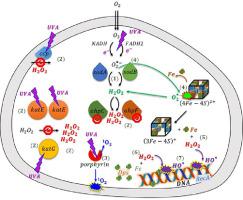Water Research ( IF 11.4 ) Pub Date : 2022-06-13 , DOI: 10.1016/j.watres.2022.118740 Stefanos Giannakis 1 , Anshika Gupta 2 , Cesar Pulgarin 3 , James Imlay 2

|
Solar disinfection (SODIS) was probed for its underlying mechanism. When Escherichia coli was exposed to UVA irradiation, the dominant solar fraction acting in SODIS process, cells exhibited a shoulder before death ensued. This profile resembles cell killing by hydrogen peroxide (H2O2). Indeed, the use of specialized strains revealed that UVA exposure triggers intracellular H2O2 formation. The resultant H2O2 stress was especially impactful because UVA also inactivated the processes that degrade H2O2—peroxidases through the suppression of metabolism, and catalases through direct enzyme damage. Cell killing was enhanced when water was replaced with D2O, suggesting that singlet oxygen plays a role, possibly as a precursor to H2O2 and/or as the mediator of catalase damage. UVA was especially toxic to mutants lacking miniferritin (dps) or recombinational DNA repair (recA) enzymes, indicating that reactions between ferrous iron and UVA-generated H2O2 lead to lethal DNA damage. Importantly, experiments showed that the intracellular accumulation of H2O2 alone is insufficient to kill cells; therefore, UVA must do something more to enable death. A possibility is that UVA stimulates the reduction of intracellular ferric iron to its ferrous form, either by stimulating formation or by generating photoexcited electron donors. These observations and methods open the door to follow-up experiments that can probe the mechanisms of H2O2 formation, catalase inactivation, and iron reduction. Of immediate utility, the data highlight the intracellular pathways formed under UVA light during SODIS, and that the presence of micromolar iron accelerates the rate at which radiation disinfects water.
中文翻译:

识别 UVA 光下细胞内大肠杆菌失活的介质:(照片)芬顿过程和单线态氧
探究了太阳能消毒(SODIS)的基本机制。当大肠杆菌暴露于 UVA 照射(SODIS 过程中起作用的主要太阳部分)时,细胞在死亡之前表现出肩部。该曲线类似于过氧化氢 (H 2 O 2 ) 杀死细胞的效果。事实上,使用特殊菌株表明,UVA 暴露会触发细胞内 H 2 O 2的形成。由此产生的 H 2 O 2应激尤其具有影响力,因为 UVA 还可以通过抑制代谢来灭活降解 H 2 O 2的过氧化物酶,以及通过直接酶损伤来灭活过氧化氢酶。当水被 D 2 O 取代时,细胞杀伤作用增强,这表明单线态氧发挥了作用,可能作为 H 2 O 2的前体和/或作为过氧化氢酶损伤的介质。 UVA 对缺乏小铁蛋白 ( dps ) 或重组 DNA 修复 ( recA ) 酶的突变体尤其有毒,表明亚铁和 UVA 产生的 H 2 O 2之间的反应会导致致命的 DNA 损伤。重要的是,实验表明,仅H 2 O 2在细胞内的积累不足以杀死细胞。因此,UVA 必须采取更多措施来实现死亡。 一种可能性是,UVA 通过刺激细胞内三价铁还原为其亚铁形式。形成或通过产生光激发电子供体。这些观察结果和方法为后续实验打开了大门,这些实验可以探讨 H 2 O 2形成、过氧化氢酶失活和铁还原的机制。这些数据突出显示了 SODIS 期间 UVA 光下形成的细胞内通路,并且微摩尔铁的存在加速了辐射对水进行消毒的速度,具有直接的实用性。











































 京公网安备 11010802027423号
京公网安备 11010802027423号